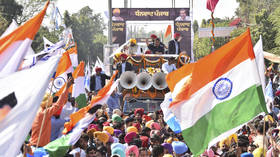'Modi factor' and AAPheaval: India's election shines a light on country's future

For about a month, the people of India have kept a close eye on the progress of assembly elections in five states with an overall population of more than a quarter of a billion people – Uttar Pradesh, Uttarakhand, Manipur, Punjab, and Goa. The importance of these polls cannot be overemphasized, since they marked a major milestone both for statewide and countrywide internal politics.
In addition to the fact that they are a sort of litmus test of public sentiment and may shift the political landscape locally, the elections also determine the distribution of 43 seats in the upper house of India’s parliament. They therefore prepare the ground for the presidential elections, which are to be held later this year. Finally, it is a great opportunity for political forces unsatisfied with results to re-examine their strategies before the general election. But first things first.
The count that came in on March 10 was a surprise for many. Despite the fact that the BJP won fewer seats compared to 2017, it managed to secure a victory in four key states. By doing so, the Saffron party made history both in Uttar Pradesh and Uttarakhand. The BJP became the first party to win consecutive terms in elections since 1985 in the most populous state of India. The same is true for Uttarakhand, where for 21 years the Congress and the BJP alternately leapfrogged each other. Moreover, the political landscape was dramatically pivoted in Punjab. In the land of Sikhs, the major rival for a ruling party at national level, the Indian National Congress, was totally overwhelmed by the new AAP (Aam Aadmi Party).
In Uttarakhand, the results were determined by the two major political forces – the INC and the BJP. Therefore, they were hard to predict. Both sides failed to estimate even an approximate number of seats they would get. If the BJP was afraid of losing its majority due to historical continuity, the Congress leaders overestimated their chances for the same reason. The opposition party claimed it would gain a two-thirds majority in the legislative assembly and allegedly corralled its own candidates in Rajasthan ‘safe houses’ to prevent poaching.
Ultimately, this didn’t help, however, and the party gained two-and-a-half times fewer seats than expected. Yet, the more than two-fold superiority of the ruling party in terms of the number of seats does not fully reflect the real state of affairs. The data suggests the party was able to outrun only by 6% in terms of the number of votes. It’s significant that five seats were gained with a margin of less than 1,000 votes, and incumbent Chief Minister Pushkar Singh Dhami lost ground in the Khatima assembly constituency. Notwithstanding personally unimpressive results, he managed to secure his post.
The results of the polls in Uttar Pradesh, a so-called stronghold for major political parties, always attracted much public attention. The elections were of strategic importance for the ruling party, given that they were considered a test of effectiveness in matters related to the ability to consolidate different groups in society. Firstly, for a long time the same party has not won there twice in a row. Secondly, there is a traditionally big role of caste factor, which determines the nature of political struggle. Thirdly, unresolved unemployment and economic recession problems breed discontent with the policies of the current government.
However, these factors were not enough to deprive the BJP of victory. The party has lost some of its seats but still overtook its key rival by more than double. This election has clearly demonstrated that the state is witnessing the formation of a de facto bipartisan system with the BJP and the SP (Socialist Party) holding 90% of the seats in the local parliament.
As a matter of fact, to some extent it was a personal showdown between the party leaders. The BJP’s last victory was attributed to the “Modi factor” – the active participation in the campaign of the widely popular Prime Minister Narendra Modi.
Now things are different. The campaign was led by the current Chief Minister Yogi Adityanath. He was opposed by national president of the SP, Akhilesh Yadav, a hereditary politician and Sydney University graduate. They are almost peers and both have similar political achievements. Modi had become the youngest member of the 12th Lok Sabha at 26 (the lower house of India’s bicameral parliament), the second was the youngest chief minister of Uttar Pradesh at the age of 38.
Yogi is a rather controversial figure both in India and within the BJP itself. He ostentatiously combines politics with religion, being also the head priest of the Hindu temple in Gorakhpur. He has often been accused of populism and of using communalist rhetoric to rally the local Hindu population around him. In particular, as a chief minister, he passed a rather ambivalent law restricting interfaith marriages in order to stop the so-called “love jihad.”
During the election campaign, he used nationalist Hindutva rhetoric, calling opponents of his party “supporters of Jinnah” (a historical Muslim leader — RT) and the elections themselves – “an issue of 80 against 20,” alluding to the ratio of Hindus to Muslims in the state. Yadav had to not only almost single-handedly resist the rhetoric and the entire administrative apparatus of the BJP, but also undertake a total rebranding of his party, which was discredited due to intra-party family contradictions and largely unsuccessful policies during the state leadership.
The results proved the effectiveness of the unification policy of the BJP. This fact can be attributed to the still-fresh memories of mass clashes between Muslims and Hindus in 2013 which resulted in the death of over 60 people. And that’s exactly why some Indian journalists and politicians dubbed the state a new “Hindutva laboratory.” Along with subjective factors, the program of financial assistance to the lower strata, carried out jointly with the central government, also turned out to be effective. The consolidated position of the ruling party on different levels (except some cases of defection) sharply contrasted with the unorganized actions of the opposition.
An example of this, inter alia, could be found in candidates’ nomination processes. In the western parts of the state, the opposition parties proposed Muslim candidates in the same constituencies, which had made it impossible for them to stand together against the BJP. A certain blow to the image was inflicted by internal contradictions in the SP camp.

AAP’s victory in Punjab perhaps came as the biggest surprise for observers. Traditionally, the dominant forces in the political arena have been the Congress and the Shiromani Akali Dal, which represents the interests of the Sikh community. The steepness of Congress’ fall was even overmatched by the AAP’s rise, a newish party formed in 2012 by Arvind Kejriwal. Such a dramatic shift is now popularly called “AAPheval.” In general, the political standoff can be characterized as a clash between generations: The two oldest parties in the country tried to becloud public visibility of a ‘supernova’. Eventually, they failed. Under the motto of ‘badlav’ (change) and the fight against corruption, the party completely decimated opponents by an overwhelming five-fold majority.
It managed to conduct a successful campaign led by its regional leader Bhagwant Singh Mann. And the key to this success was pretty similar. Apart from inspirational rhetoric, it was a disarray of key opposition parties which manifested itself in internal strife and struggles to regain traditional vote share. This victory marked the failure of regional heavyweights – for the first time in 30 years the Badal family gained no prominent membership in the assembly. Similar reasons prompted Sonya Gandhi, the president of the INC, to offer her resignation to the party leaders in Uttarakhand, Goa, Uttar Pradesh, Manipur, as well as in Punjab.
In Goa and Manipur, the ruling party succeeded. Amid a sharp decline in the number of seats gained by Congress, in Manipur the BJP has a simple majority. While the polls in Goa have led to a hung parliament but de facto the party needed to convince only one candidate to join the camp. It over-fulfilled the plan and secured the support of all independent members and representatives of the regional MGP (Maharashtrawadi Gomantak Party).
On the one hand, despite some weakening of the positions of the ruling party “on the ground,” the election results maintain its freedom of political maneuvers “on top.” The Saffron party retains the dominant share of the electoral map, controlling approximately 42% of the country’s geographical area. On the other hand, when we take a closer look, we notice some interesting characteristics. Firstly, the polls send signals that the course and rhetoric of the ruling party is still relevant. Secondly, there are signs of growing importance of women voting given that their turnout in some constituencies was even higher than men’s. Thirdly, the assembly election heralded not only the triumph of the BJP, it was also the rise of its leaders in pivotal Uttar Pradesh.
To put it bluntly, Yogi managed to reduce the role of the “Modi factor” and proved his prominence as a nationwide politician. Most importantly, assembly elections show that the role of traditional opposition parties will gradually decline until they find a consolidation mechanism to confront the current state of affairs. A convincing victory by the AAP, the party that managed to do this, is already fueling speculation that in the near future it will become a fully fledged nationwide political force.















